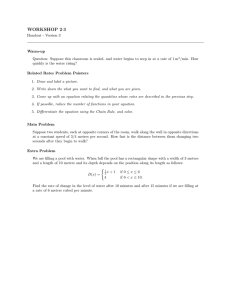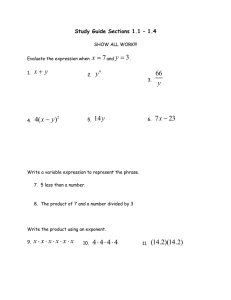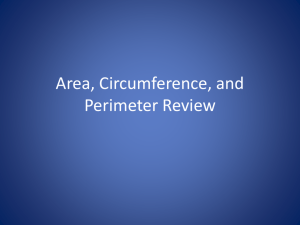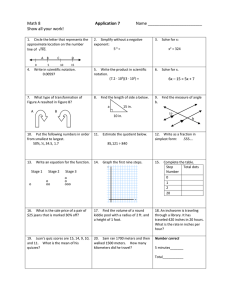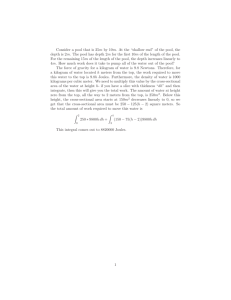POOL DIMENSIONS and RECOMMENDATIONS
advertisement
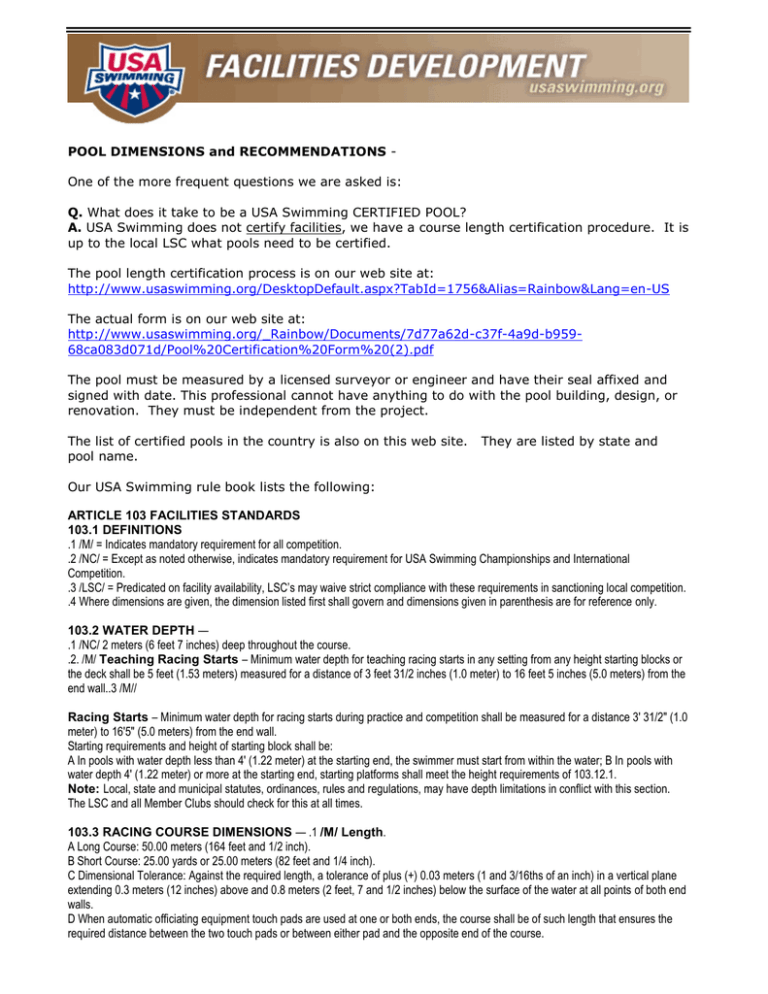
POOL DIMENSIONS and RECOMMENDATIONS One of the more frequent questions we are asked is: Q. What does it take to be a USA Swimming CERTIFIED POOL? A. USA Swimming does not certify facilities, we have a course length certification procedure. It is up to the local LSC what pools need to be certified. The pool length certification process is on our web site at: http://www.usaswimming.org/DesktopDefault.aspx?TabId=1756&Alias=Rainbow&Lang=en-US The actual form is on our web site at: http://www.usaswimming.org/_Rainbow/Documents/7d77a62d-c37f-4a9d-b95968ca083d071d/Pool%20Certification%20Form%20(2).pdf The pool must be measured by a licensed surveyor or engineer and have their seal affixed and signed with date. This professional cannot have anything to do with the pool building, design, or renovation. They must be independent from the project. The list of certified pools in the country is also on this web site. pool name. They are listed by state and Our USA Swimming rule book lists the following: ARTICLE 103 FACILITIES STANDARDS 103.1 DEFINITIONS .1 /M/ = Indicates mandatory requirement for all competition. .2 /NC/ = Except as noted otherwise, indicates mandatory requirement for USA Swimming Championships and International Competition. .3 /LSC/ = Predicated on facility availability, LSC’s may waive strict compliance with these requirements in sanctioning local competition. .4 Where dimensions are given, the dimension listed first shall govern and dimensions given in parenthesis are for reference only. 103.2 WATER DEPTH — .1 /NC/ 2 meters (6 feet 7 inches) deep throughout the course. .2. /M/ Teaching Racing Starts – Minimum water depth for teaching racing starts in any setting from any height starting blocks or the deck shall be 5 feet (1.53 meters) measured for a distance of 3 feet 31/2 inches (1.0 meter) to 16 feet 5 inches (5.0 meters) from the end wall..3 /M// Racing Starts – Minimum water depth for racing starts during practice and competition shall be measured for a distance 3' 31/2" (1.0 meter) to 16'5" (5.0 meters) from the end wall. Starting requirements and height of starting block shall be: A In pools with water depth less than 4' (1.22 meter) at the starting end, the swimmer must start from within the water; B In pools with water depth 4' (1.22 meter) or more at the starting end, starting platforms shall meet the height requirements of 103.12.1. Note: Local, state and municipal statutes, ordinances, rules and regulations, may have depth limitations in conflict with this section. The LSC and all Member Clubs should check for this at all times. 103.3 RACING COURSE DIMENSIONS — .1 /M/ Length. A Long Course: 50.00 meters (164 feet and 1/2 inch). B Short Course: 25.00 yards or 25.00 meters (82 feet and 1/4 inch). C Dimensional Tolerance: Against the required length, a tolerance of plus (+) 0.03 meters (1 and 3/16ths of an inch) in a vertical plane extending 0.3 meters (12 inches) above and 0.8 meters (2 feet, 7 and 1/2 inches) below the surface of the water at all points of both end walls. D When automatic officiating equipment touch pads are used at one or both ends, the course shall be of such length that ensures the required distance between the two touch pads or between either pad and the opposite end of the course. E When the racing course is fixed by the use of movable bulkheads, such bulkheads shall be designed to resist lateral deflection due to tension exerted by the attachment of the lane dividers to ensure the required course distance in all lanes. F See Article 104, Rules for Swimming Records, for course measurements certification requirements. .2 Width. A /NC/ Eight lanes, minimum width of 2.5 meters (8 feet 21/ inches), from center line to center line of the lane dividers, with approximately 0.45 meters (1 foot 6 inches) of additional open water outside lanes 1 and 8. Program Operations may waive this requirement for National Championships. B /M/ Minimum lane width for competitive swimming shall be 7 feet (2.13 meters). /LSC/ 103.4 /M/ RACING COURSE WALLS — .1 Permanent Course Walls — Walls enclosing the racing course shall be parallel and vertical. The end walls shall be at a right angle to the water surface and shall be constructed of solid material with non-slip surface that extends no less than 0.8 meters (2 feet 7 and 1/2 inches) below the water surface. . 2 Movable Bulkhead Course Walls — If a continuous recessed hand grip is provided at or near the water surface in a movable bulkhead, the horizontal dimension of the recess perpendicular to the bulkhead should be not less than six inches (.15 meters) and designed in a manner to prevent the swimmer’s fingers from contacting the back surface of the recess. 103.5 /M/ POOL AND BULKHEAD MARKINGS — .1 Pool bottom lane markers: Minimum 10 inch (25 centimeter) wide lines of a dark contrasting color (preferably black) shall be provided in the middle of each racing lane on the bottom of the pool. The lines should be uninterrupted the length of the course and shall end with a distinctive cross line 1.0 meters (3 feet 4 inches) long and the same width as the bottom marker. The line, including the cross line, shall terminate 2.00 meters (6 feet 7 inches) from each end wall. /LSC/ .2 End wall targets: Flush, non-slip targets in a shape of a ―T‖ or a cross and the same width as the lane bottom markers shall be provided in the center of each lane on each end wall of the course and shall extend at least 3 feet 4 inches (1.0 meters) below the level of the water surface. It is recommended that the top edge of the deck be of a contrasting color to provide a visual target above water at the end of the course. /LSC/ .3 A The lanes shall be numbered from right to left as the swimmers stand facing the course. /LSC/ B Lane numbers shall clearly identify the lanes to officials stationed on each side of the course. 2005 Rules & Regulations 44 103.6 /M/ OVERFLOW RECIRCULATION SYSTEM — The pool water recirculation and overflow system shall maintain water level in line with the overflow rim of the pool gutters without creating appreciable current or water turbulence and shall maintain smooth and calm water surface during competition. The pool recirculation system shall be turned off if, in the opinion of the Referee, the water movement interferes with the conduct of competition. 103.7 WATER AND AIR TEMPERATURE — .1 /M/ Water temperature between 78 and 80 degrees Fahrenheit shall be maintained for competition. .2 Air temperature within 8 feet above deck level in indoor facilities shall be not lower than 76 degrees Fahrenheit, with relative humidity maintained at about 60% and air velocity at about 25 feet per minute. 103.8 /M/ LADDERS — All ladders, steps or stairs within the racing course shall be recessed in the pool side walls or shall be removed during competition. 103.9 OTHER DECK EQUIPMENT — .1 Use of portable lifeguard chair stands and other deck fixtures is recommended and they should be removed from the competition area to allow free passage and unobstructed view for competitors and officials along all sides of the course. /LSC/ .2 /M/ 1 meter diving boards which overhang the racing course shall be hinged out of the way or removed during competition. 103.10 /M/ LIGHTING — .1 A minimum of one hundred (100) foot candle illumination level is required at the water surface over the entire course. Overhead light fixtures shall be located to avoid the casting of shadows by the pool walls over the racing course. /LSC/ .2 /NC/ At National Championships the same type and level of illumination that will be used for finals must be provided and maintained during the warmup period and preliminaries. 103.11 /M/ NO SMOKING SIGNS — No smoking indoors or outdoors shall be permitted in any area designated for swimmers and the facility shall be so posted. 103.12 /M/ STARTING PLATFORMS — .1 Height. A Long course and short course meters: The front edge of the starting platform shall be no less than 0.50 meters (1 foot 8 inches) nor more than 0.75 meters (2 feet 5 and ½ inches) above the surface of the water. B Short Course yards: The front edge of the starting platform shall be not higher than 2 feet 6 inches (0.762 meters) above the surface of the water. .2 The front edge of the starting platform shall be flush with the face of the end walls. .3 The top surface of the starting platform shall be not less than 0.50 by 0.50 meters (1 foot 8 inches square) and shall slope not more than 10 degrees from the horizontal. The entire surface of the platform shall be faced with permanent non-slip material. For a complete .pdf copy of the USA Swimming rules and regulations, please visit: http://www.usaswimming.org/_Rainbow/Documents/92062db1-06cf-4c09-99a0-f8a0e2a17007/2011%20Rule%20Book.pdf Recommendations (NOT RULES) : Our pool rules are written for facilities that will bid for a national championship level meet. Very few pools have the “budget” or “need” to meet all of these requirements. When considering design, we make the following recommendations. Please keep in mind that local and state codes will always take precedent over our recommendations…… Pool Length – Short Course 25 yards (25 meters is not a popular distance in most areas of swimming). The 25 yard pool should be built 75 feet 1 & 3/16” long. This measurement has a 0 tolerance for being shorter and should not be more than fractions of an inch longer. Long Course 50 meters. The 50 meter pool should be built 50.03 meter long with the same tolerances applicable as above. Pool Depth – At the starting block end 6’ (or deeper) is recommended. Our rules currently allow “experienced swimmers” to dive from the side or starting blocks into 4’ of water. This rule can be changed at any time. For novice swimmers who are just learning head first entry techniques, we require 6’ water depth minimum. The turning end should be a minimum of 4’ deep. This depth works well for most other aquatic programming such as adult exercise and learn-to-swim. The more 4’ water available for programming the better. There will be a slope from the 6’ water depth to the 4’ water depth usually starting 26’ from the starting block end wall. The degree of this slope will be governed by state codes. Lanes – The width of the swimming lanes will be decided by the programming. Normal width for age group swimming is 7’ wide lanes. If upper level competition will be held for high school and older swimmers, then 8’ lanes should be considered. Some pools install extra lane line anchors so they can switch back and forth from 7’ to 8’ lanes. Some university pools may consider 9’ lanes. The number of lanes will depend on programming needs. Usually 6 lanes are minimum for Short Course pools and 8 lanes minimum for Long Course pools. The exception being that the pool is a teaching pool adjacent or close to the main pool. Then fewer lanes may be considered. 8 lanes is the standard most popular pool being designed. 10 lane pools are becoming more popular because of the room needed to support program growth. The 10 lane pool can be designed 75’ 1 & 3/16” one direction and 25.03 meters the other direction. Many pools add an extra 3’ to the total width of the pool so they can have an 18” wide buffer lane/area between the outside lanes and the gutter wall. Long Course pools have the ability to be built 75’ 1 & 3/16” wide so Short Course can be swam the width of the pool and Long Course the length. This configuration allows 23 x 7’ wide Short Course lanes. Other considerations: Lighting should be able to be “staged” or banked for different types of programs. 50 ft. candles is minimum for normal daily activities. Extra banks of lights on separate circuits can be used to increase lighting for special events. Natural daytime lighting through sky lights and windows is also beneficial as long as glare on the surface of the pool is controlled. Because of city water being chloraminated and other contributing factors that can cause water quality problems from chloramines, Medium Pressure Ultra Violet water treatment units are highly recommended (imperative) for all indoor pools. Never build a single pool. A bigger pool with bulkheads does not meet the water temperature control needs for Total Aquatic Programming. Always build the second or third separate pool with its own circulation and filter system. Temperature Access and Depth (TAD) must meet programming needs. For additional information please contact USA Swimming Facilities Development Department mnelson@usaswimming.org
